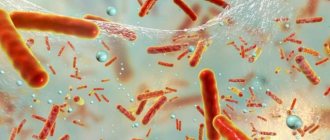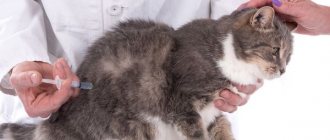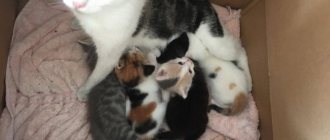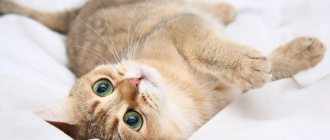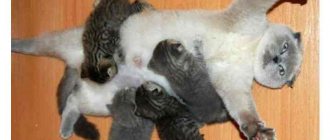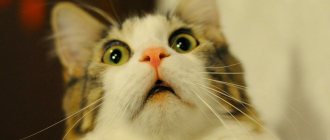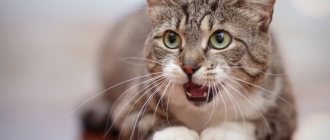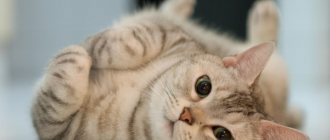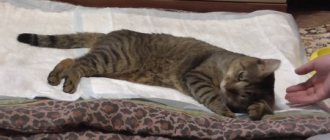However, it also happens that for some reason very young kittens are left without a mother or the cat does not have milk, and they need human help. How can I help them? Let's try to figure it out.
Hunger is the main problem facing kittens, and therefore, all the owner’s efforts must be devoted to feeding the kittens and supporting their developing body. The process of feeding a kitten is not simple, and therefore the slightest nuances are important. Before you start feeding a kitten, it is advisable to obtain basic knowledge about its growth and development.
One of the most important indicators that a kitten is developing is weight gain. This is why it is necessary to weigh the kitten daily in the first couple of weeks of its life. Subsequently, weighing can be done every 3 days.
A newly born cat baby should weigh about 110-125 grams. Properly fed kittens will double this weight in a week. Then the kitten should gain about 100 grams weekly. Small weight gains indicate either illness or malnutrition.
What to do if your cat has little milk or no milk?
You should know that newborn kittens sleep almost all the time when they are full. After all, kittens spend the first 3 weeks of life only eating and sleeping. And if newborn kittens scream all the time, it means something is bothering them and most likely it’s hunger. In order to find out whether a newborn kitten is hungry, it needs to be weighed every day at the same time. Remember that the minimum weight gain for a newborn kitten is 7 grams per day. If the growth is less, then the cat has little milk and the kitten is hungry, it needs to be fed with a special mixture for kittens or 10% cream, from a syringe or bottle, and the feeding process itself can be watched in the video.
Complex therapy is needed here. To begin with, if there is little or no milk, you need to restore hormonal balance. Therefore, every day for two weeks we subcutaneously inject the cat with the veterinary drug Ovariovit at a dosage of 1 ml per day, which is an excellent remedy for restoring and improving lactation.
Secondly, you need to improve the nutrition of a nursing cat if she has little or no milk. Know that a nursing cat needs a lot of liquid to produce milk and feeding only dry food is not suitable for her. Add fermented milk products (kefir, cottage cheese), meat (turkey, beef), eggs (chicken yolk or whole quail) to the diet of a nursing mother.
In the first days after the birth of a kitten, and then once every three days during lactation, give the cat a nutritious mixture of 10% cream, raw quail egg and 5% glucose (for 20 ml of cream, 5 ml of glucose and one egg).
A nervous, aggressive and easily excitable cat that has little milk should be injected subcutaneously with the veterinary drug Fospasim for a week, 1 ml per day, which will reduce nervous excitability and stabilize the mental state of the nursing cat.
And here you will find tips on proper care of your cat after giving birth.
Did you like the article and was it useful? Please share with your friends.
___________________________________
A cat does not have milk after giving birth: reasons, what to do to restore lactation and what to feed kittens
The natural diet of a nursing cat-mother should consist of the following products:
- meat (veal, rabbit, turkey) and offal (liver) - up to 50% of the total daily requirement;
- boiled fish without bones - it can replace meat 1-3 times a week;
- dairy products (cottage cheese, yogurt, low-fat cream) – up to 30% of the daily requirement;
- quail and chicken eggs, boiled or raw – 1-2 pcs. in Week;
- chopped vegetables – up to 10%.
If a cat eats natural food, it must be given vitamin supplements intended for nursing animals, for example, Farmavit NEO for pregnant and lactating cats, 8 in 1 Excel Brewers, etc.
The lack of milk in a pet that has given birth should alert the owner. This phenomenon may be the result of stress, in which case rest and good nutrition will help. If milk is not produced due to pathology, the animal must receive veterinary care within 1-2 days after birth.
Feeding and drinking a nursing cat
To prevent problems with milk in a cat, you must follow a number of rules.
First of all, organize complete and sufficient feeding of the expectant mother. In the last period of pregnancy and during lactation, the cat is fed ad libitum; in other words, it should receive as much food as it can eat. There is no need to worry about your pet gaining excess weight - the energy costs of milk production are such that this does not threaten the nursing mother.
Drinking is of particular importance for normal milk production - this is understandable, since along with milk, not only nutrients and biologically active substances leave the mother’s body, but also a large amount of liquid.
Clean, fresh water should always be near the “nest”. In addition, you can give your cat wet food in addition to dry food or dietary broths cooked with lean meat.
What's wrong with the cat or reasons for the lack of milk
Normally, cats produce milk immediately after the end of labor. It can also arrive only 2-3 hours after the kittens are born.
If the babies squeak loudly, their tummies are empty, and they try to constantly suckle their mother, it means that there is no milk in the cat’s mammary glands.
This happens for the following reasons:
- Stress. Pets giving birth for the first time can be very nervous and aggressive. They cannot understand what is happening to them, they worry and even abandon their offspring.
- Endometritis or pyometra. Such diseases are a consequence of inflammation of the uterus. With pyometra, a large amount of pus accumulates in its cavity. In this case, you can determine what is wrong with the cat by the symptoms: heavy breathing and shortness of breath, the appearance of purulent discharge from the noose, restless behavior.
- Not released afterbirth. Normally it should come out within a couple of hours. If this does not happen, the animal is given an injection of the drug Oxytocin.
- Eclampsia. With this disease, an acute deficiency of calcium occurs in the cat’s body. The animal begins to have convulsions. The pet is worried, walks poorly, hides, and refuses to feed the babies.
- Mastitis. This term refers to inflammation of the mammary glands in a cat. At the same time, they become hot and hard. The animal is in severe pain and does not allow the kittens to approach the nipples.
- Lack of maternal instinct. In rare cases, a cat does not produce milk after giving birth, so she refuses to accept her babies, since her maternal instinct does not awaken.
- Incorrect and poor diet. If your cat doesn't get enough nutrients from her diet during pregnancy, she may not produce milk after giving birth.
We suggest you familiarize yourself with: What types of magpies are there? Due to various circumstances, a new mother may either have no milk or have insufficient quantities. There may be several reasons for the violation:
- Stress. This happens to first-time cats. Without such experience, such pets do not understand what is happening to them. Some may behave aggressively. And sometimes this happens because the cat is having a protracted labor. If fertilization occurred on the 2nd and 5th days of mating, then kittens can be born at intervals of two days. During this period, the cat behaves restlessly and even aggressively. She refuses to feed the born kittens because lactation processes have not yet started in her body.
- Delay of placenta. If this is indeed the case, then the woman in labor is gently stimulated with injections of calcium borogluconate or oxytocin. This causes the uterus to contract and the afterbirth will come out. If it grows, surgical intervention will be required.
- Lack of maternal instincts. Animals have natural parental instincts. But they also have exceptions to the rules. Some cats are not at all interested in the fate of their offspring and do not feed them. For some, lactation processes do not work, so they, like cuckoos, give birth and abandon their young. If you observe such an abnormal situation with your pet, caress her, bring her to the kittens, talk to her, and gently put her in a box with the babies. Put the kittens to the nipples and wait for them to taste the milk - this helps awaken the maternal instinct.
- Pyometra. If after giving birth a new mother behaves restlessly, does not eat, breathes heavily, hides in dark corners, and has white discharge from the loop, then most likely this is purulent inflammation of the uterus. This insidious disease requires urgent treatment, otherwise the cat may die. The cause of pyometra is severe distension of the uterus or a failed placenta - it rots inside the uterus. Localized inflammation develops. Pyometra can be treated by taking antibiotics or undergoing sterilization, after which the cat will no longer be able to have kittens.
- Wrong diet. In the postpartum period, the mother needs a balanced menu, she needs to drink more. Dairy products, eggs, and meat should always be present in the diet. To enhance lactation, you can make a special cocktail from 10% cream, 5% glucose, 1 raw quail egg. Everything needs to be mixed and offered to the pet.
If a mother feeds her offspring, but the babies squeak constantly, it means they are malnourished. This is fraught with a slowdown in their development, general weakness, and vulnerability to infectious diseases. To ensure malnutrition, kittens can be weighed every day. The minimum growth rate for a newborn kitten is 7 grams per day.
Malnourished kittens differ from their healthy counterparts by having sunken tummies. This can be seen with the naked eye: they are lethargic, apathetic, and hardly move.
When does a cat produce milk?
Before childbirth, the mammary glands of the expectant mother swell noticeably; when pressed, a translucent liquid (colostrum) may be released from them. Normally, a cat produces milk immediately after giving birth. Sometimes after 1-2 days, and before this time, colostrum is released from the nipples, which is also suitable for the first feedings.
If an animal gives birth for the first time, the arrival of milk may be slightly delayed (3-5 days). This usually happens in artificially bred breeds. Selected cats have dulled natural instincts, so problems and pathologies during and after childbirth occur more often.
What to do and how to improve lactation: effective ways
To correct the situation, you need to contact a veterinarian and rule out some pathologies such as mastitis. If your cat has lost milk, you can cope with the problem or increase the amount of fluid using several methods that can be used at home. When a female exhibits other alarming symptoms and changes in behavior, it is important to promptly contact a veterinary clinic, where they will prescribe a series of laboratory and instrumental tests to help refute/confirm such diseases:
- mastitis;
- endometritis;
- purulent inflammation of the uterus;
- postpartum eclampsia.
If the lack of milk is associated with a hormonal imbalance, then therapy is used by prescribing the hormones necessary for the cat. The following medications are often prescribed for hormonal imbalance after childbirth:
- "Oxytocin";
- "Mastometrin";
- "Ovariovitis."
Before the birth of kittens, the owner must make a special place for the cat, which should be warm and comfortable, it is better that it is located in a darkened part of the room. It is important, especially in the first days after birth, to provide the female with peace and avoid stress. For a normal amount of milk, they monitor the diet of the cat who has given birth, which is fed cottage cheese, cream, fermented baked milk, and vegetables. Such products improve the functioning of the mammary glands and enhance lactation.
When does a cat produce milk?
Typically, cats produce milk immediately after their babies are born. At this time, the animal’s body releases the hormone oxytocin, which stimulates lactation. Also, a few days before the onset of labor, the first drops of colostrum may be released from the nipples.
For various reasons, milk production may begin only 2-3 hours after all kittens are born. Babies instinctively find the nipples and begin to stimulate them, which allows milk to flow into the mammary glands.
Increasing the amount of milk in a cat
Proper care and proper nutrition are the basis for healthy lactation for a new mother. Milk or kefir should be in her diet daily. Let the bowl with food be next to the box where the kittens and mother are staying. And veterinarians also advise using one secret if there is a shortage of milk: the food needs to be slightly salted - this will make the cat drink more and increase lactation.
There is no need to introduce new foods into the cat’s diet during the postpartum period; give mommy the food she loves. Be kind and attentive to her.
Rules for feeding motherless kittens
If newborn kittens are left alone and their mother leaves, becomes seriously ill or dies, it is necessary to feed them yourself. Before this, you should prepare special equipment.
- Heat source. Kittens need a special nest temperature. It is maintained at 38 degrees. You can use a special medical electric heating pad or hot water bottles wrapped in a towel. The top of the box containing the babies is covered with a warm shawl or blanket.
- Feeding mixture. To feed such babies, it is better to use special ready-made mixtures. They can be purchased at a veterinary pharmacy or online pet store. You cannot use whole cow's milk for this purpose, since it differs significantly from cat's milk in composition and can cause diarrhea in babies.
- Utensils for feeding. You should purchase one or more special bottles, or make them yourself. To do this, place a rubber pipette tip on the spout of a large-volume syringe (10-20 ml).
We invite you to familiarize yourself with: Central Russian bee characteristics and features
Feeding mode
The rules for feeding kittens without a mother are as follows:
- In the first 7 days after birth, babies are fed up to 12 times a day, including at night. These babies are fed 1.5 tsp of formula milk.
- By 2 weeks, the feeding regimen changes, and the number of meals is reduced to 6. A two-week-old kitten eats about 3 teaspoons of the mixture at a time.
- At 3 weeks, babies eat 3-4 times a day. The volume of mixture consumed at a time is 1-2 tbsp. At this age, babies begin to be fed other foods. To do this, you can use minced meat or finely chopped lean meat (chicken, turkey, veal, rabbit). Instead of meat, you can give your kids soft cottage cheese.
- By 5 weeks, kittens are fed three times a day. At this age, babies eat formula milk (3-4 tablespoons at a time) and additional complementary foods in the form of meat and dairy products.
- At 6 weeks, the amount of mixture is increased to 5 tablespoons.
Feeding methods
Breeders practice different ways of feeding newborn babies. Bottle feeding is considered the most convenient. Veterinary pharmacies sell special containers designed for feeding small kittens.
The second method is feeding from a spoon or from a pipette. The spoon is suitable for babies who are already 2 weeks old. At the same time, during feeding, you should not tilt the kitten’s head back too much, as it may choke. For pets that are not yet 2 weeks old, pipette feeding is more suitable.
The third method is to use a medical syringe. In this case, the nose should be directed towards the kitten's sky, in which case it grabs it like a mother's nipple. The syringe plunger is moved very slowly, and the mixture should flow out in small drops.
How to stop lactation (milk production) in a cat if the kittens have died or been taken apart
Hello! If the cat does not have inflammation, swelling, redness, has a good appetite and is feeling well, then nothing additional should be applied, the milk will disappear by itself, this process simply cannot end in one day. Play with her more, pay her attention. Let the cat move more. If symptoms of illness appear, immediately contact a veterinary clinic for an appointment.
Unfortunately, there are a lot of opinions both on the Internet and among veterinary specialists about how to stop milk production in a cat. And what’s most difficult is that many of these tips are very contradictory. Based on this, I think that you need to take the most accessible and reasonable advice, and in moderation.
For example, to stop lactation, it is advised to stop feeding the cat for 48 hours and not give it liquid. Try this, but keep an eye on your cat's condition. If she is already too weak, perhaps you should simply limit the amount of protein food and water, that is, not completely stop feeding and drinking, but reduce the usual dose of food and liquid by half. In addition, as a rule, it is quite difficult for loving pet owners not to feed or water the animal at all.
Other tips include giving your cat a small dose of a diuretic, such as Parlodel (bromocriptine). True, when consuming it, the animal may vomit. Therefore, you can try Galastop. It is prescribed to bitches for the treatment of false pregnancy and suppression of lactation for clinical indications (for example, early weaning of puppies). The use of Galastop prevents lactation, breast enlargement and the development of lactation mastitis. The drug is administered orally with food or forcefully on the tongue at a dose of 0.1 ml (3 drops) per 1 kg of animal weight for 4 to 6 days. If there is no effect or symptoms of false pregnancy appear after stopping the drug, the course can be repeated. Very rarely, some animals may experience single vomiting, lack of appetite or drowsiness in the first two days of treatment, which does not require discontinuation of the drug. In what exact dose to give them to your cat, it is better to consult with a veterinarian during an in-person examination of the cat, and based on the animal’s body weight. You can read more about this drug at the following link: https://www.vetlek.ru/directions/?id=148
Do not bandage your cat's belly or put a blanket on it. There is an opinion that such a procedure, on the contrary, will only increase milk. It is also not recommended to smear the cat’s tummy with camphor oil. It is also believed that it can increase milk flow.
Health to you and your pets!
How to make kittens go to the toilet?
Take a piece of cloth, moisten it with water and wipe the kitten's tummy with gentle massaging movements, similar to the movement of a cat's tongue. If you do everything correctly, then “toilet chores” will happen several times a day.
Breeders involved in breeding cats and simply owners of these animals are often faced with the fact that the cat does not have enough milk for kittens. What should they do in this case?
First of all, the animal owner should carefully examine all kittens, paying special attention to their tummies. If the kittens have enough milk and are full, then their tummies should be plump and well-fed. If their bellies sink, then this is a clear sign that their mother’s milk is not enough for everyone.
In order to cope with this problem and for the cat to produce more milk, you will need to provide the cat with additional nutrition by introducing the necessary additions to its diet.
However, first of all, you should ensure that her diet is sufficiently plentiful, nutritious and balanced.
In order for more milk to arrive, the cat should first drink more. But, unfortunately, it is almost impossible to force a cat to drink more, so its food needs to be slightly salted in order to stimulate the animal’s feeling of thirst.
Another method is broths, preferably also salted, with which you can tempt the animal. In addition, milk and dairy products should be introduced into the cat’s daily diet, which also contribute to the milk supply. True, regular milk may not be suitable for this; in this case, the cat should be offered yogurt or kefir, preferably goat milk.
A cat may have low milk supply due to low-calorie food.
A big mistake is made by those owners and novice breeders who, trying to make a cat’s diet more nutritious, abruptly switch it to a different diet. This should not be done under any circumstances. For example, if a cat has been eating only dry food until now, then it cannot be immediately switched to natural food or vice versa. Such castlings, instead of the expected arrival of milk, can lead to the opposite option, and in its worst manifestation, when the milk disappears altogether.
In addition to the methods described above, you can also use purely tactical ones, when the cat’s food and drink are placed as close to it as possible. This method really helps, since many young mother cats are simply afraid to leave their babies unattended and come to the feeder almost once a day, after which they immediately return.
Of course, with such a meager diet, there can be no talk of any abundance of milk. This situation can easily fall out of sight of a breeder who keeps many animals at once.
In addition to medications, a calm and quiet environment helps combat stress.
The breeder must be careful and monitor how often the cat approaches food and how much it eats.
In this case, you need to organize a separate feeder for the mother cat: it is much more convenient to monitor her nutrition when she has her own feeder and bowl of water. Of course, immediately after eating, the food should be removed, since the other cats will very quickly realize that they have another place where they could have a snack. It’s a troublesome matter, but such is the fate of the breeder.
However, if the cat eats well and drinks a lot, and there is still not enough milk for everyone, then the breeder has only one way to save the kittens. To do this, he will have to take some of the kittens under his personal responsibility and begin additional feeding. Fortunately, you can easily purchase special mixtures for kittens in specialized pet stores. You should not give extra food to all kittens at the same time. It would be much more effective to select the weakest and feed them.
If you choose the more active and larger ones, then, most likely, having eaten formula, they will still try to drink their mother’s milk, out of habit, taking it away from their less proactive brothers.
If you find an error, please select a piece of text and press Ctrl+Enter.
The cat has little milk
General rules and recommendations for hosts
First of all, you need to make sure that all kittens receive food on time. To do this, the owner independently places them next to the mother every two hours.
Of course, in most cases the furry mother does this on her own, but unforeseen situations happen when she refuses to do this.
Together with mother's milk, kittens receive all the necessary vitamins and microelements to strengthen their body. In turn, during pregnancy, the ward may begin to lose her beauty and get sick.
To prevent the nurse from experiencing anxiety and discomfort, you need to monitor her nutrition. Cat food must be appropriate for the breed and selected specifically for nursing mothers. Such food already contains all the necessary beneficial elements that a cat needs during milk production.
In order to choose the right nutrition, pay attention to the composition of the food; it must be rich in: calcium, minerals and trace elements.
Important! It is worth considering that she will feed the kittens for up to two months. Energy consumption will increase several times.
In order not to overdo it with nutrition or to avoid underfeeding , the owners need to create a small schedule according to which the nursing mother will eat. She, like kittens, should be fed small portions every few hours.
The nurse should not overeat and feel hungry; it is also necessary to monitor water consumption. A healthy mother who is nursing kittens consumes more than 250 ml of water per day. By observing this norm, she will not suffer from dehydration.
The food of a nursing mother should not only be varied, but also contain all the necessary substances.
Cat milk replacers and kitten formulas
Many cat owners believe that small kittens can only be fed with cow's milk, but this opinion is wrong. This product will cause babies to have diarrhea and they will not grow well. Special milk substitutes and formulas should be chosen as the main diet for newborn kittens.
The following industrial cat milk replacers are commercially available:
- Beaphar Kitty Milk. The product is manufactured in the Netherlands. The dry powder is diluted in warm water in the following proportion: 7 grams of mixture per 50 grams of liquid. The resulting product can be stored in the refrigerator for 8 hours. Before the next feeding, it is heated to 40 degrees. The average cost of a milk substitute is 800-1200 rubles. per jar 200 gr.
- Gimpet Cat-Milk with added taurine. The manufacturer of this product is Germany. The compositions of the Gimpet substitute and cat milk are almost identical. The powder is dissolved in hot water in the ratio: 1 tbsp. mixture to 3 tbsp. liquids. The average price of a 200 g jar is 700-900 rubles.
- Royal Canin Babycat Milk. This product is made in France. 10 grams of powder are dissolved in 20 ml of warm water. The resulting mixture must be fed to the babies within 60 minutes. The price of a package weighing 300 grams varies from 900 to 1300 rubles.
We invite you to read: Cats scratch at their souls - why they say so and what it means
It is permissible to use infant formula for kittens only if it is not possible to purchase a complete cat's milk substitute. When choosing, carefully study the composition of the product: it should contain no sugar.
To feed small pets, baby formula is diluted in warm water, but the recommended amount of liquid is doubled. The diluted milk is stored in the refrigerator for 24 hours. Before the next meal, the required amount of the mixture is heated and given to the babies.
If you can’t buy a ready-made milk replacer, you can make Scott’s formula for kittens using this recipe:
- Whole cow's milk – 50 g.
- Whole milk powder – 15 g.
- Chicken egg – 1 pc.
- Whipped chicken egg white – 1 pc.
- Dry yeast – 2.5 g.
- Glucose – 4 g.
- Vegetable oil – 1 gr.
This mixture is fed to babies in the amount of 23-25 grams per day. It is preheated to a temperature of 40 degrees.
Tiling mixture for kittens is prepared from the following ingredients:
- Whole milk (both cow and goat milk are suitable) – 25 g.
- Whole milk powder – 5 g.
- Glucose solution – 2 g.
- Crushed vitamins for kittens – 1g.
The mixture components are mixed well. All dry ingredients should dissolve in the milk. Before feeding, the liquid gruel is heated to 40 degrees. This mixture is given to kittens, following general recommendations.
Signs of underfed kittens
It is very important to detect in a timely manner that newborn kittens are not eating enough to prevent mortality and morbidity among the offspring. How can you tell if a cat doesn't have milk? The following signs that you need to pay attention to will help with this:
- When you press on the nipple, a drop of milk should appear. This manipulation needs to be done at the time of feeding, since the cat’s milk is not constantly in the mammary glands, but when the kittens stimulate the nipples. And if a drop of milk does not appear at this moment, it is worth taking a closer look at the kittens’ behavior.
- Hungry babies are restless, look for nipples, squeak, and do not sleep after feeding. Hungry or underfed kittens crawl around looking for a food source. Well-fed cubs fall asleep almost immediately after the next intake of milk, sometimes right at the mother's nipple.
- Some cats, if they do not have milk, are reluctant to be near kittens and abandon them. Other animals with agalactia continue to “feed” their offspring, take care of them, warm them, and lick them. In this case, the behavior of the kittens will be an indicator of underfeeding.
- More reliable information that a cat does not have enough milk can be obtained by regularly weighing the babies. During the day, with a normal supply of food, the cub gains at least 10 grams in weight. If within a few days the increase is less than this or is completely absent, this is a serious symptom that the kitten is starving and its life is under threat.
We invite you to read: Favorable period for sterilization of a cat and castration of a cat. Preparing a cat for sterilization and methods of sterilization, care after sterilization. The process of castration and rehabilitation of a cat Kitten weight by month
| Kitten weight per month | 500-750 gr |
| Kitten weight at 2 months | 1000-1500 gr |
| Kitten weight at 3 months | 1700-2300 gr |
| Kitten weight at 4 months | 2500-3600 gr |
| Kitten weight at 5 months | 3100-4200 gr |
| Kitten weight at 6 months | 3500-4800 gr |
The presence of one, and even more so several of the listed signs of lack or lack of milk in a cat, is a signal for the owner to take immediate measures to stimulate lactation in the animal.
What to do if a nursing mother’s milk disappears
There is nothing better for a baby than breast milk. Breastfeeding not only strengthens the baby’s immunity, but also affects the mental connection between mother and baby. Almost every nursing mother has encountered periods when milk becomes insufficient.
So that the baby does not suffer from hunger and does not waste energy sucking on an empty breast, women are forced to start feeding the child with formula. However, you should not rush to switch from natural feeding to artificial feeding.
What to do if breast milk disappears? There are safe and effective methods that help increase breast milk production and maintain natural nutrition for the baby.
How to determine if your baby has enough milk
Many young mothers ask the question: “How to understand that breast milk is disappearing”? Usually, already in the first month of a baby’s life, the mother becomes clear whether the baby will suckle at the breast and whether he has enough milk.
But what to do if the baby is already 3-6 months or more, and there is a feeling that the child is not getting enough to eat. You can determine that a baby is not getting enough milk by the following signs:
The child is capricious during and after feeding, sucks the breast for a long time and with effort. This behavior cannot be considered as the only and reliable sign of a lack of milk, but it is worth taking note as an “alarming” bell. All signs should be assessed together. This will allow you to get a real picture of what is happening.
The baby began to urinate less often, and the diaper remains dry for a long time. This sign is especially relevant for children under 6 months of age who are exclusively breastfed. If you count all urinations in 24 hours, then the child pees less than 12 times a day.
The baby is not gaining weight well. Although weighing before and after feeding is not objective, weighing the baby once a week is quite normal.
Source
Vitamins and supplements needed for babies
Artificially fed kittens need to be given vitamins and mineral supplements. From 4 weeks you can give your babies Canina Cat-Mineral Tabs. It is a source of calcium and phosphorus, promotes the proper formation of bone and cartilage tissue.
From 6 weeks, kittens can be given the Kitty's Junior supplement from the Beafar company. This drug improves the quality of babies' fur and has a beneficial effect on the skin, as it contains biotin.
Also, from 1 month, kittens can be given Gelabon Glucosamine tablets from the Polydex company. This drug, like Canina, promotes the proper formation of cartilage and bone tissue in babies.
What to feed kittens if there is not enough mother's milk or no milk at all?
Immediately after birth and for 3-4 weeks, mother's milk is the main source of existence for babies. The lack of milk (agalactia) threatens newborns with starvation, and the lack of secretions in the mother (hypogalactia) threatens the underdevelopment of the cubs. Every owner of a furry pet who has given birth to kittens should know what to do if a cat does not have milk. The life and health of the offspring depend on timely detection of signs of lack of nutrition and the adoption of measures.
Read in this article
Why does the cat lose or have no milk?
Owners of cats that have recently given birth are sometimes faced with the fact that the cat has lost milk or has not produced milk at all.
Also, the animal may ignore babies and not show maternal instincts. So, let's figure out why a cat doesn't have milk , and how to help her and the kittens.
Sometimes it happens that a young cat “refuses” newborn kittens: she does not lick, does not feed, and tries to run away. In this case, the owners can only feed the babies themselves, which is quite troublesome. What could be the reasons for this behavior of the mother cat?
Just like with women, everything is individual. Perhaps the cat is not eating adequately, and due to exhaustion (or lack of necessary substances) milk is not produced. If the cat has lost milk , let's drink warm milk, you can also buy Apillac tablets at a “human” pharmacy and give the animal a quarter. This drug promotes milk production in lactating women, but it can also be used in animals. And, of course, if the problem is in the cat’s diet, reconsider it, perhaps it’s worth diversifying it and adding vitamin supplements.
Another reason for the lack of maternal instinct in cats is hormonal imbalances. Often, owners are in a hurry to breed a breeding cat at a young age in order to get offspring as quickly as possible; as a result, its hormonal system is not fully formed. With the second birth, as a rule, everything goes without problems.
An explanation for why a cat does not produce milk may be congenital malformations. In this case, in the future, with subsequent pregnancies, the problem will not disappear. There may also be a lack of milk if the animal is sick; most often this is due to pyometra (purulent inflammation of the uterus) and infection.
Source
Feeding kittens: when to start
Beginning cat owners don't always know when to start giving their babies other foods. Feeding kittens begins when the kittens are 3-4 weeks old.
Used as additional food:
- Dry food. The following products are suitable for babies aged 1 month: Royal Canin Baby Cat, ProPlan Optistart, Almo Nature Kitten, Safari Kitten. The food granules are first soaked in warm water and then made into a semi-liquid paste. This mixture is offered to kittens. By 1.5 months, babies are good at chewing unsoaked crackers.
- Raw meat. Suitable for kittens: turkey, rabbit, veal, quail, chicken. The meat is cut into small cubes and offered to children.
- Dairy products. The best option for first feeding is soft, low-fat cottage cheese. You can also offer your kids 10% cream and fermented baked milk.
What to feed
Beginning owners are interested in what to feed kittens if they refuse meat or dairy. In this case, you can offer children canned food (the composition should not contain starch, soy and other additives) or special kitten pates.
Artificial feeding of kittens is a process that takes a lot of time and effort. To feed babies, it is necessary to use special formulas that completely replace mother's milk. Any questions should be directed to veterinarians or experienced breeders.
How to tell if kittens don't have enough milk
If your cat seems to be feeding the kittens, but they constantly scream, it means that the babies regularly do not finish eating. And, this is dangerous due to the slowdown in their development processes, their general weakness and vulnerability to dangerous diseases. To make sure that the babies are truly malnourished, you can check their weighing every day at the same time, or weigh the kitten before and after feeding.
Veterinarians call the minimum weight gain in a newborn kitten 7 grams per day.
If your kittens have less growth, it means they are not eating enough. In this case, it would be appropriate to supplement them with special formulas for kittens, which, although they cannot replace mother’s milk, contain vitamins and minerals, or 10% cream from a bottle or syringe.
The feeding process is really difficult - considering that kittens eat little and often, and they need to be fed even in the middle of the night, but by doing so you will save them from starvation and grief.
Visually, kittens that do not finish eating differ from their “finishing” counterparts by having sunken tummies, lethargy and apathy.
back to contents
Problems with lactation as a symptom
Normally, a cat's lactation begins immediately after birth or a few days before the birth of the offspring. Several complex mechanisms are responsible for the production of milk in the mother's body, but they all depend on hormonal levels. From the first day of conception until the end of lactation, the level of oxytocin in the cat’s body increases. The amount of this hormone is constantly increasing. A critical concentration of oxytocin leads to the initiation of labor and active lactation. In fact, if everything goes naturally, the cat’s milk actively comes in during contractions and pushing.
A few days before giving birth, a clear discharge may ooze from your cat's nipples, indicating that the mammary glands are open. This is a good sign, since nothing will interfere with the flow of milk. During this period, the cat intensively licks the nipples, which stimulates increased blood circulation in the tissues.
After the birth of the first kitten, the cat gnaws the umbilical cord, eats the afterbirth and pushes the baby towards the nipples. The process of feeding a kitten serves as additional stimulation for the onset of new contractions, and if all kittens are born, for the contraction of the uterus to a normal state.
In the first 4–5 days, the young mother feeds the babies every 2–3 hours. Note that immediately after childbirth, the mother’s body produces colostrum, not milk. In composition, colostrum is more saturated and contains a lot of:
- Nutrients (proteins) – a source of nutrition.
- Friendly lacto- and bifidobacteria - after birth, there are no bacteria in the intestines of kittens, and the process of further digestion depends on what microflora gets into it. Colostrum contains optimal microflora; statistics show that almost all artificially fed kittens suffer from dysbiosis.
- Antibodies - during the entire period of feeding and until about 3 months of life, kittens do not have their own immunity; they receive antibodies from the mother. After the end of feeding, the concentration of antibodies in the blood of kittens decreases, they become defenseless against viruses and infections. For prevention, kittens at the age of 3–4 months begin a course of basic vaccination.
- Water – newborn kittens, like their mother, experience dehydration in the first hours after birth. For kittens, this condition is considered more serious, so the mother’s body sacrifices itself to save the offspring. Your task is to take care of mom and help her restore water reserves in her body.
The cat independently decides how long to feed the kittens. Typically, a young mother begins to avoid feeding when the kittens reach the age of 1-2 months. At this point, the cat has a natural decrease in active lactation.
At about one month of age, babies' incisors begin to emerge, the cat experiences severe discomfort during feeding and begins to avoid babies. The kittens have no choice but to look for other food sources.
At about one month of age, the owner needs to start feeding the babies. If the cat is kept on industrial food, then the kittens are fed with special baby pate. If the animal eats natural food, the kittens are given boiled minced meat, broth, dairy and fermented milk products.
If the pregnancy proceeded normally, but lactation did not begin, the reasons may lie in hidden or congenital pathologies. Be sure to consult a veterinarian who will examine your cat before prescribing any therapy. Self-treatment in this case is very dangerous, since drugs that promote lactation will cause harm if the mammary gland channels are closed for some reason.
When a cat has inflammation of the mammary glands, lactation usually does not occur or stops. Be sure to keep the litter in the nest clean. Immediately after birth and in the first few days of lactation, the body of a young mother is vulnerable to bacteria and infections. During the feeding period, the mammary gland channels are open, which can lead to infection.
During the entire period of feeding the offspring, the health of the young mother must be closely monitored. A cat suffering from a flea infestation is constantly nervous, and its immune system is in a state of constant agitation, which can lead to weakened lactation.
A helminthic infestation can lead to weak lactation or its cessation. When planning a mating, both parents must be treated for worms. If the mating was spontaneous, most likely the cat is infected with parasites, which harms not only her, but also her offspring. While the worms are parasitic in the mother’s body, she constantly suffers from intoxication, which affects the condition of the kittens.
Unfortunately, lack of lactation can be a very serious symptom. There are two common pathologies: postpartum eclampsia and lactostasis. Lactostasis can be acquired or congenital. In cases of natural or congenital lactostasis, the cause of the disease lies in the malfunction of the brain. This condition cannot be treated, so the only alternative is artificial feeding of kittens.
Acquired lactostasis most often develops due to stress or overwork during childbirth. In this case, kittens must be fed artificially, but not taken away from their mother. The baby will instinctively suckle from its mother, which will stimulate the onset of lactation.
Postpartum eclampsia is a deadly condition for a young mother, caused by a critically low level of calcium in the blood. Eclampsia is a hereditary disease; moreover, if a cat falls into a state of hypocalcemia after the first birth, the complication will most likely recur in all subsequent births.
We suggest you familiarize yourself with: Rules for mating purebred cats or how to breed a British cat and get offspring.
Eclampsia must be stopped in a short time; for this purpose, calcium preparations are used, which are administered intramuscularly or intravenously. The main symptoms of postpartum eclampsia are: increased body temperature, tremors, increased salivation, seizures, heavy breathing with an open mouth, discoloration of the mucous membranes. Typically, the clinical picture progresses over several hours, after which the young mother falls into a coma and dies.
How and what to give to kittens if their mother has not started lactation?
Please note that a cat who has gone into heat and has lost her milk will most likely abandon her kittens. Moreover, in the most unfavorable cases, she can simply eat them. If you want to save the babies’ lives, you will have to take on all the burdens of care. This applies not only to feeding: when raising cubs, you need to remember about numerous nuances, the observance of which determines both the health and life of the offspring.
First, examine the babies: remember that they are normally constantly moving and twitching, even when they have not yet learned to walk. If the kitten is not sleeping but looks lethargic and inactive, this is not good. In their sleep, kittens are quite calm and can practically not change the position of their body. When a baby is constantly spinning and meowing, it can mean two things: either it has some kind of health problem, or (more likely) it is very hungry.
In case you had to take on the responsibilities of a cat mother, make it a rule to examine your pets daily. Healthy young kittens have warm skin and small, round tummies (provided they are well fed). In addition, strong babies must have a strong, pronounced sucking reflex.
If kittens are healthy, they tend to beg for milk about once an hour (or once every two hours, but not less often). Accordingly, they will have to be fed with the same frequency (regardless of the time of day). The main sign of satiety of the “swallows” will be a slight swelling of their tummies and a “sudden” calmness.
In the first week, kittens, having just had their fill, fall asleep almost instantly. They sleep, as we already indicated above, for about an hour. If your pets instead fuss and squeak, then they probably don’t have enough formula. In this case, the rounding of the abdomen can be ignored: most likely, this is air that has entered the stomach during a constant squeak.
Other nuances
Of course, you shouldn’t lick the kittens’ belly yourself: for this purpose you need to use a regular cotton pad soaked in warm saline solution or plain water. They also need to remove animal feces from their bodies.
Another problem is the tendency of kittens to become hypothermic. Their body can independently maintain a temperature of no more than 35° Celsius, and this is not enough for accelerated metabolism. It is for this reason that the mother almost never leaves the cubs in the first weeks of their life, working as a “hot water bottle.” If the cubs left without mother's care are not warmed, they will quickly die.
In ideal cases, you need to find another nursing cat and “throw” new cubs at her. In this case, you need to take a “donor” litter kitten and carefully wipe the foundling on it. Otherwise, the cat will not accept a baby that smells like another animal.
Their composition is radically different from that of cats, and therefore the use of such “ersatz” often leads to severe diarrhea. The latter, as you know, is deadly for small kittens! Babies can die from dehydration within hours.
What brands of “baby food” can I use to feed kittens? In our country, they are produced by famous manufacturers, such as Royal Canin, Beaphar, Canina.
We suggest you read: Keratitis in cats: treatment, photos
Considering that they are not found in every pet store, it is advisable to consult with a veterinarian in advance. When using such tools, remember the following:
- You can find both liquid and powdered substitutes on sale, and the latter, as you might guess, must be diluted with boiled, settled and warm water before use. As a rule, it is necessary to comply with the same requirements and recommendations as in the case of baby food (i.e., it must be diluted thoroughly, without lumps, the temperature of the finished mixture is within 37-38° Celsius.
- Remember that there are milk formulas on sale intended for feeding adult cats. Such mixtures are ordinary skim cow's milk, from which all lactose has been additionally removed. Diverging slightly from the topic, we note that such food does not bring any particular benefit to adult cats (nor does it cause any harm). It can be given to kittens only in extreme cases, when there are no other options. Moreover, this should be done no more than two or three times, while searching for more suitable food for them.
Let's assume that you don't have milk or formula. What else can you give kittens? Experienced veterinarians say that babies can be given thick rice water two or three times. Of course, there are not enough nutrients there, but this thick jelly will allow the kittens to fill their tummies and fall asleep. At this time, you can also find a suitable milk formula for them.
After the kittens reach 4 weeks of age, they need to be taken away from the nursing mother for 2-3 hours to a separate room where a toilet, water and food are provided. The first few days, take it for one interval of 2-3 hours, then twice a day. As the kittens grow older, they will be able to stay on their own without their mother cat for longer and longer periods of time.

